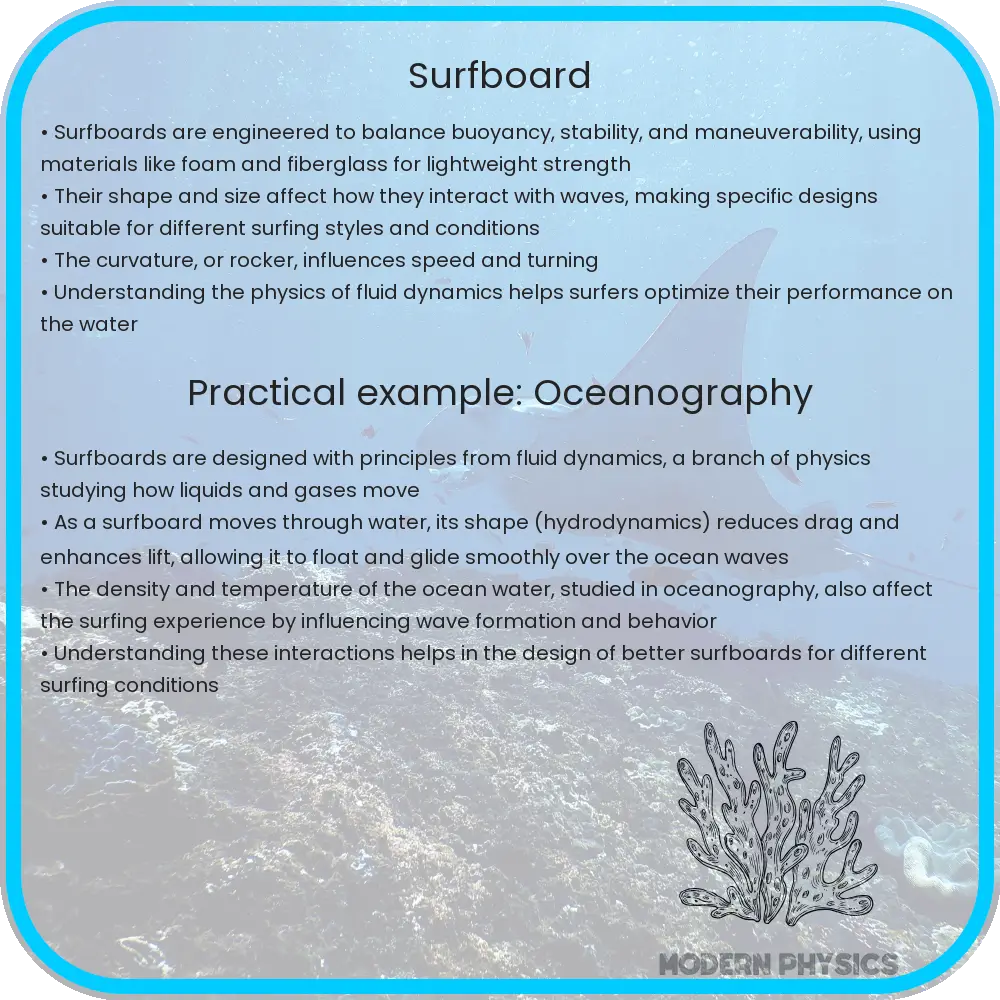Explore the science of surfing with insights on surfboard dynamics, wave interaction, and balance. Learn how design and physics enhance your ride.

Understanding Surfboard Dynamics: The Science of Wave Interaction
The art of surfing, a dance between the surfer and the sea, is fundamentally rooted in the principles of physics and fluid dynamics. Surfboard dynamics, particularly in relation to wave interaction, balance, and motion, are crucial for both novice and seasoned surfers to understand. This article delves into the scientific aspects that make surfing possible, exploring how surfboards interact with waves, maintain balance, and facilitate motion.
Wave Interaction and Surfboard Design
At the heart of surfing is the interaction between the surfboard and the ocean waves. Waves are energy traveling through water, and this energy is what surfers harness. The design of the surfboard plays a pivotal role in how efficiently it can catch a wave. Factors such as board length, width, and thickness directly influence buoyancy and stability. A longer board, for instance, offers more buoyancy and is better for beginners, while shorter boards provide greater maneuverability for advanced maneuvers.
The curvature of the board, known as the rocker, is also crucial. A higher rocker allows for sharper turns, making it suitable for steeper waves. Conversely, a flatter rocker enhances speed in smaller waves. The bottom contours, including concaves and channels, further dictate how water flows under the board, affecting speed and control.
Balance and Stability
Balance on a surfboard is a complex interplay of forces. The surfer’s center of gravity must align with the buoyant force provided by the water. This is why surfers constantly shift their weight and stance to maintain equilibrium. The board’s design, including its volume and rail shape, contributes to its overall stability. Wider boards with thicker rails offer more stability, which is ideal for beginners.
Advanced surfers, however, often prefer thinner rails and narrower boards for better sensitivity and responsiveness. The tail shape also affects stability. For example, a square tail offers more stability, while a rounded tail allows for smoother turns.
Surfboard Motion and Propulsion
Movement in surfing is a result of the combined forces of the wave’s energy and the surfer’s actions. When a surfer paddles and catches a wave, the gravitational force pulls them down the wave’s face, converting potential energy into kinetic energy. This energy propels the surfboard forward. The surfer’s ability to navigate this energy, through body movements and board control, is essential for successful surfing.
Maneuvering the board involves tilting and twisting it to adjust its path. This is where the board’s fin setup comes into play. Fins help in directional stability and are crucial for turns and tricks. Different fin configurations offer varying degrees of control and stability, influencing the surfing experience.
Surfing, at its core, is a beautiful synergy of human skill and natural forces. Understanding the dynamics of surfboards in relation to wave interaction, balance, and motion not only enhances the surfing experience but also deepens one’s appreciation of this exhilarating sport.
The Role of Hydrodynamics in Surfing
Hydrodynamics, the study of fluids in motion, is central to understanding how surfboards interact with water. As a surfer moves across a wave, the shape of the surfboard dictates the flow of water around it, influencing speed and agility. The rails, the edges of the board, play a vital role in cutting through the water. Sharper rails allow for cleaner, more precise turns, while softer rails provide a smoother, more forgiving ride.
Additionally, the concept of planing comes into play. As speed increases, the surfboard begins to plane, essentially riding on top of the water rather than pushing through it. This reduces drag and allows for faster, more efficient surfing. The design of the surfboard, including its rocker and bottom contours, affects its planing efficiency.
Environmental Factors in Surfing
Environmental factors such as wind, tide, and wave type also significantly impact surfboard dynamics. Offshore winds, blowing from land to sea, can create cleaner, more well-defined waves, ideal for surfing. Onshore winds, conversely, tend to make the sea choppy and the waves less predictable.
The tide influences the shape and break of the waves. High tide usually means slower, fuller waves, while low tide can produce faster, more hollow waves. Understanding these environmental aspects can help surfers choose the right surfboard and strategies for the conditions.
Technological Advancements in Surfboard Design
Technological advancements have also revolutionized surfboard design. Materials like epoxy, carbon fiber, and expanded polystyrene (EPS) foam have led to lighter, stronger, and more responsive boards. Computer-aided design (CAD) allows for precise shaping and customization, catering to the specific needs and preferences of individual surfers.
Conclusion
The world of surfing is a fascinating blend of art, science, and nature. Understanding the dynamics of surfboards in relation to wave interaction, balance, and motion is crucial for both enjoying and excelling in this sport. It involves a deep appreciation of the ocean’s rhythms and the physics of movement, as well as a keen sense of one’s own body and how it interacts with the surfboard. The ongoing evolution in surfboard design continues to push the boundaries of what is possible on the waves, offering endless opportunities for discovery and mastery. For those passionate about surfing, this knowledge is not just technical; it’s a pathway to a more profound connection with the sea and the sport itself.
